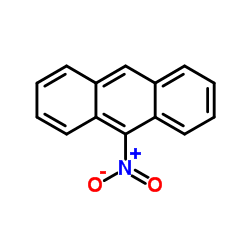9-Nitroanthracene

9-Nitroanthracene structure
|
Common Name | 9-Nitroanthracene | ||
|---|---|---|---|---|
| CAS Number | 602-60-8 | Molecular Weight | 223.227 | |
| Density | 1.3±0.1 g/cm3 | Boiling Point | 402.9±14.0 °C at 760 mmHg | |
| Molecular Formula | C14H9NO2 | Melting Point | 144-144ºC | |
| MSDS | Chinese USA | Flash Point | 200.4±12.9 °C | |
|
Preparation, Structural Determination, and Characterization of Electronic Properties of Bis-silylated and Bis-germylated Lu3 N@Ih -C80.
Chemistry 21 , 16411-20, (2015) Bis-silylated and bis-germylated derivatives of Lu3 N@Ih -C80 (3, 4, 5) were successfully synthesized by the photochemical addition of disiliranes 1 a, 1 b or digermirane 2, and fully characterized by spectroscopic, electrochemical, and theoretical studies. I... |
|
|
9-Nitroanthracene derivative as a precursor of anthraquinone for photodynamic therapy.
Bioorg. Med. Chem. 15(11) , 3869-73, (2007) Anthraquinones are typical photosensitizers used in photodynamic therapy (PDT). However, systemic toxicity is a major problem for anthraquinones due to their ability not only to bind DNA but also to cause oxidative stress even without photoirradiation. To avo... |
|
|
Xanthine oxidase-catalyzed DNA binding of dihydrodiol derivatives of nitro-polycyclic aromatic hydrocarbons.
Biochem. Biophys. Res. Commun. 141(1) , 245-50, (1986) Xanthine oxidase, a mammalian nitroreductase, catalyzed the covalent binding of a series of nitro-polycyclic aromatic hydrocarbons (nitro-PAHs) trans-dihydrodiols to DNA. Some of the trans-dihydrodiols bound to DNA to a greater extent than their parent nitro-... |
|
|
HPLC retention behavior of poly-aromatic-hydrocarbons on aminopropyl silica gels modified with Cu(II)- and Ni(II)-phthalocyanine derivatives in non-polar eluent.
Chem. Pharm. Bull. 52(1) , 41-6, (2004) A comparative study was conducted to elucidate the mechanism underlying the separation of poly-aromatic-hydrocarbons (PAHs) and related compounds thereof on a column packed with silica gels modified with Ni(II)- or Cu(II)-phthalocyanine derivatives (PCS) (Ni-... |
|
|
Contamination is a frequent confounding factor in toxicology studies with anthraquinone and related compounds.
Int. J. Toxicol. 23(5) , 335-44, (2004) Anthraquinone (AQ) (9,10-anthracenedione) is an important compound in commerce. Many structurally related AQ derivatives are medicinal natural plant products. Examples include 1-hydroxyanthraquinone (1-OH-AQ) and 2-hydroxyanthraquinone (2-OH-AQ), which are al... |
|
|
Application of 9-nitroanthracene as a matrix for laser desorption/ionization analysis of fluorinated fullerenes.
Rapid Commun. Mass Spectrom. 18(3) , 360-2, (2004)
|
|
|
Nitropolycyclic aromatic hydrocarbons are inducers of mitotic homologous recombination in the wing-spot test of Drosophila melanogaster.
Food Chem. Toxicol. 46(7) , 2344-8, (2008) In this study, the widespread environmental pollutants 1-nitronaphthalene (1NN), 1,5-dinitronaphthalene (1,5DNN), 2-nitrofluorene (2NF) and 9-nitroanthracene (9NA), were investigated for genotoxicity in the wing somatic mutation and recombination test (SMART)... |
|
|
One-step synthesis of [16]helicene.
Angew. Chem. Int. Ed. Engl. 54 , 6847-51, (2015) A single-strand arylene-vinylene precursor containing four phenylene and three naphthylene units linked together with six vinylene spacers undergoes helical folding via sextuple photocyclization to give a [16]helicene core in a single step. The phenylene and ... |
|
|
High Fluorescent Porphyrin-PAMAM-Fluorene Dendrimers.
Molecules 20 , 8548-59, (2015) Two new classes of dendrimers bearing 8 and 32 fluorene donor groups have been synthesized. The first and second generations of these porphyrin-PAMAM-fluorene dendrimers were characterized by 1H-NMR, 13C-NMR, FTIR, UV-vis spectroscopy, elemental analyses and ... |
|
|
9-Nitroanthracene.
IARC Monogr. Eval. Carcinog. Risk Chem. Hum. 33 , 179-85, (1984)
|